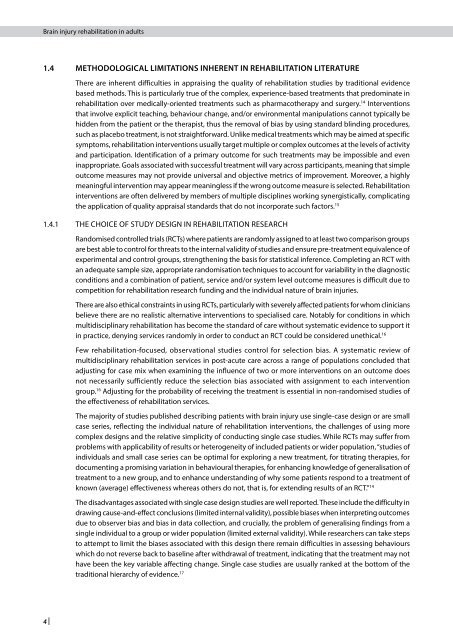sign130
sign130
sign130
Create successful ePaper yourself
Turn your PDF publications into a flip-book with our unique Google optimized e-Paper software.
Brain injury rehabilitation in adults<br />
1.4 METHoDoloGICAl lIMITATIoNS INHERENT IN REHABIlITATIoN lITERATuRE<br />
4 |<br />
There are inherent difficulties in appraising the quality of rehabilitation studies by traditional evidence<br />
based methods. This is particularly true of the complex, experience-based treatments that predominate in<br />
rehabilitation over medically-oriented treatments such as pharmacotherapy and surgery. 14 Interventions<br />
that involve explicit teaching, behaviour change, and/or environmental manipulations cannot typically be<br />
hidden from the patient or the therapist, thus the removal of bias by using standard blinding procedures,<br />
such as placebo treatment, is not straightforward. Unlike medical treatments which may be aimed at specific<br />
symptoms, rehabilitation interventions usually target multiple or complex outcomes at the levels of activity<br />
and participation. Identification of a primary outcome for such treatments may be impossible and even<br />
inappropriate. Goals associated with successful treatment will vary across participants, meaning that simple<br />
outcome measures may not provide universal and objective metrics of improvement. Moreover, a highly<br />
meaningful intervention may appear meaningless if the wrong outcome measure is selected. Rehabilitation<br />
interventions are often delivered by members of multiple disciplines working synergistically, complicating<br />
the application of quality appraisal standards that do not incorporate such factors. 15<br />
1.4.1 THE CHOICE OF STUDy DESIGN IN REHABILITATION RESEARCH<br />
Randomised controlled trials (RCTs) where patients are randomly assigned to at least two comparison groups<br />
are best able to control for threats to the internal validity of studies and ensure pre-treatment equivalence of<br />
experimental and control groups, strengthening the basis for statistical inference. Completing an RCT with<br />
an adequate sample size, appropriate randomisation techniques to account for variability in the diagnostic<br />
conditions and a combination of patient, service and/or system level outcome measures is difficult due to<br />
competition for rehabilitation research funding and the individual nature of brain injuries.<br />
There are also ethical constraints in using RCTs, particularly with severely affected patients for whom clinicians<br />
believe there are no realistic alternative interventions to specialised care. Notably for conditions in which<br />
multidisciplinary rehabilitation has become the standard of care without systematic evidence to support it<br />
in practice, denying services randomly in order to conduct an RCT could be considered unethical. 16<br />
Few rehabilitation-focused, observational studies control for selection bias. A systematic review of<br />
multidisciplinary rehabilitation services in post-acute care across a range of populations concluded that<br />
adjusting for case mix when examining the influence of two or more interventions on an outcome does<br />
not necessarily sufficiently reduce the selection bias associated with assignment to each intervention<br />
group. 16 Adjusting for the probability of receiving the treatment is essential in non-randomised studies of<br />
the effectiveness of rehabilitation services.<br />
The majority of studies published describing patients with brain injury use single-case design or are small<br />
case series, reflecting the individual nature of rehabilitation interventions, the challenges of using more<br />
complex designs and the relative simplicity of conducting single case studies. While RCTs may suffer from<br />
problems with applicability of results or heterogeneity of included patients or wider population, “studies of<br />
individuals and small case series can be optimal for exploring a new treatment, for titrating therapies, for<br />
documenting a promising variation in behavioural therapies, for enhancing knowledge of generalisation of<br />
treatment to a new group, and to enhance understanding of why some patients respond to a treatment of<br />
known (average) effectiveness whereas others do not, that is, for extending results of an RCT.” 14<br />
The disadvantages associated with single case design studies are well reported. These include the difficulty in<br />
drawing cause-and-effect conclusions (limited internal validity), possible biases when interpreting outcomes<br />
due to observer bias and bias in data collection, and crucially, the problem of generalising findings from a<br />
single individual to a group or wider population (limited external validity). While researchers can take steps<br />
to attempt to limit the biases associated with this design there remain difficulties in assessing behaviours<br />
which do not reverse back to baseline after withdrawal of treatment, indicating that the treatment may not<br />
have been the key variable affecting change. Single case studies are usually ranked at the bottom of the<br />
traditional hierarchy of evidence. 17


